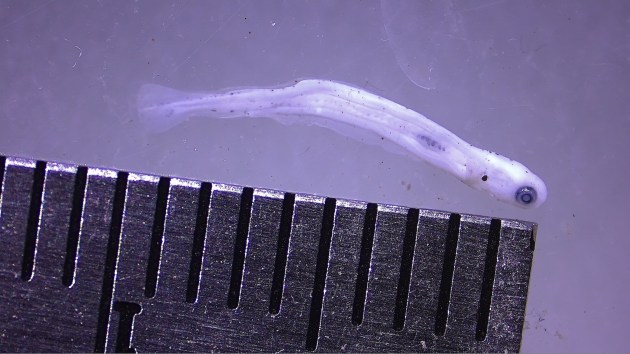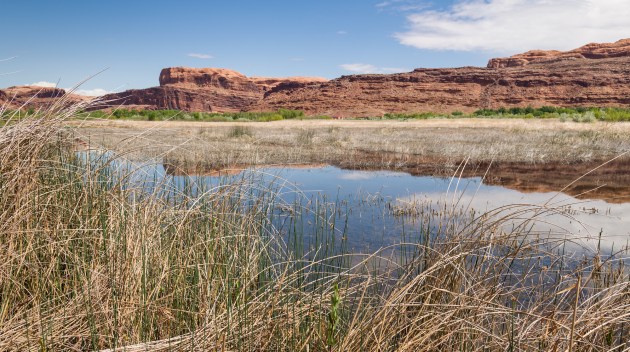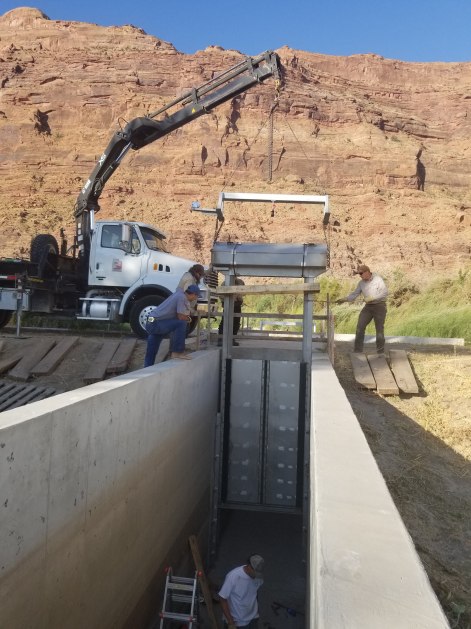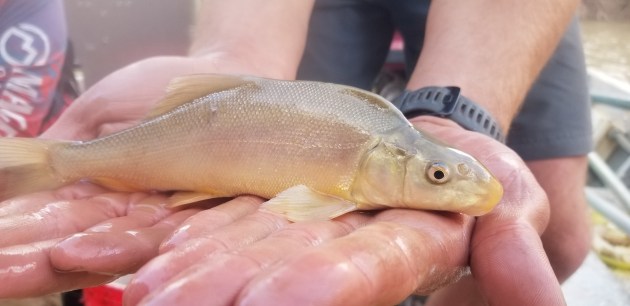A Nature Conservancy preserve in Moab, Utah offers hopeful news for endangered razorback suckers: this fall, 51 juvenile suckers were recorded on the property’s fish nursery, which began operation in 2020.
I visited the Scott and Norma Matheson Preserve, where the nursery is located, in 2019. It was under construction at the time, and the hope was it would provide critical habitat that the endangered suckers were lacking.
Razorback suckers are chunky fish with ridged back (hence their name). They have thrived in the adjacent Colorado River for millions of years but recent decades have put them and other native species at risk. They have faced a litany of threats including altered flows and temperatures caused by dams, habitat degradation and predation by non-native fishes.
Despite these threats, razorback suckers can and do live in the Colorado River. The problem is, they need to be perpetually stocked. “When we survey the river, we find adult suckers. We find baby suckers,” says Sam Brockdorff, a biologist with Utah Division of Wildlife Resources. “The problem is, we don’t find juvenile suckers.”
Those juvenile suckers lack the flooded wetland habitat they need for protection. That’s the need that the Matheson Preserve is fulfilling.

Where Have All the Larvae Gone?
The Matheson Preserve has provided an oasis for wildlife for decades. That was immediately apparent to me when I visited in 2019. Just a couple blocks from the red rocks, arches and arid landscape of Moab, the 920-acre preserve offers riparian vegetation that provides a refuge for migratory birds.
Now it’s also providing refuge for native fishes.
It’s a rough river for larval razorback suckers. The Colorado is now home to more than 70 non-native fishes, fishes the larvae were not adapted to elude.
“The larvae look like little noodles with big black eyes,” says Linda Whitham, manager of the preserve. “And the non-native fishes just feast on them like they’re finger food.”

I also fished during my 2019 visit and caught catfish after catfish out of the river. These predatory fish create a seemingly impossible gauntlet for larvae to run. And as if that wasn’t enough, small non-native minnows also compete for the same zooplankton the young suckers need.
Once the suckers grow larger, they are not at much risk of predation. “There is not really any fish going to eat a full-grown sucker,” says Brockdorff. “They can live 40 years in the river. But they have to survive past the larval stage.”
The Nature Conservancy and Utah DWR partnered to give razorback suckers a fin up in this tough environment. At the time of purchase, the property was identified as having potential for a fish nursery – perhaps the only suitable location to re-create sucker rearing habitat on a 63-mile stretch of river.
“This isn’t a hatchery situation,” says Brockdorff. “It’s re-creating their rearing habitat.”
“The goal was to give them a place for the larvae to grow large enough to survive their next phase of life,” says Whitham. ‘It’s a place to grow and thrive in relative protection.”

Building a Nursery
Construction of the nursery began in 2017. Just as with a baby’s nursery, a fish nursery has to provide comfort (in the form of flooded wetland habitat) and safety (from non-native predatory fishes).
During that time engineers and construction workers expanded the Central Pond – now known as the native fish nursery – on the Matheson Preserve. They connected the nursery to the main stem of the Colorado via a channel to the pond. A separate pipeline was installed to move fresh water from a nearby spring into the nursery.

Then workers built a water control device and installed a specially designed gate and screens which allow the larvae safe passage to the nursery. The screens allow passage of the larvae but not larger predatory fishes.
The gate remains closed until they grow sufficiently, then they’re released back into the river.
The nursery officially “opened” in 2020. In the first few years, only six total juveniles were recorded. This was not unexpected. The nursery was dependent on flows from the Colorado River.
“We were happy to even see a few suckers,” says Whitham. “It also gave us time to work the bugs out.”
Glo-sticks – the kind that kids love to play with on summer evenings – were put by the fish screens to attract larval suckers into traps. This lets researchers know that suckers are present, so they can time the opening of the gates correctly. After a couple of years, biologists also added a supplemental water pipeline to keep fresh water flowing into the preserve even if river pulse levels dropped.
And then, last year, the Colorado River experienced flood conditions: the pulse required to get more suckers into the nursery. The one problem was that flows were so high that non-native fishes flooded into the preserve too.
“I didn’t have a lot of hope that there would be any razorback suckers,” says Whitham.
But biologists electroshocked the pond and removed non-natives, perhaps aided by a couple of hungry otters. “It turns out the same breaches that allowed non-natives again, also allowed a lot of larvae,” says Brockdorff.

And the results were incredibly hopeful for all involved, with more than 50 larvae recorded. Those suckers were eventually released back in the river, with a tag that allows them to be tracked by Utah DWR.
Whitham emphasizes there’s still a lot to learn and tweaks to be made to make the nursery more effective. “Biologists are learning what the conditions were that made this year so successful,” she says.
The research and continued refinement will help give the fish a chance to survive to adulthood and perhaps reach their 40-year lifespan.
Creating the nursery resulted in secondary benefits. It enhanced connectivity of the Colorado River and the pond, increasing wetland habitat for hundreds of native species as well as supporting conditions that reduce the threat of wildfire.
“This is one of the coolest fishes in the world.”
Sam Brockdorff
The nursery also presents another opportunity: for outreach. Attention and love for native fishes is growing in local communities and beyond. The razorback sucker is featured on a new, prominent mural in Moab. Preserve visitors who come for nature walks and birding now learn that the local fishes are charismatic, too.
“This is one of the coolest fishes in the world,” says Brockdorff. “We have a real opportunity here, not only to better help the suckers survive, but also for outreach. Around Moab, everyone loves these fish. The nursery gives an opportunity to reach more people about native fish conservation.”




The biggest of blessings to all those who understood what was needed here and then did all the needed things! This makes my heart happy…